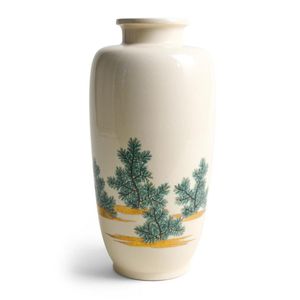Rare Japanese Kyoyaki 'Wakamatsu' Vase by Ito Tozan I
A rare Japanese Kyoyaki 'Wakamatsu' vase by Ito Tozan I (1846-1920), Meiji period (1868-1912) or Taisho period (1912-1926), the cylindrical baluster form vase of classic ivory-hued Kyoto stoneware with finely crackled clear glaze, sparsely decorated to the lower part with 'Wakamatsu' motif in overglaze enamels and fine gilding. Impressed circular seal for Tozan I to the base. Together with the tomobako (original signed wooden box). 24.5 cm high, 11.5 cm diameter, other notes: Ito Tozan I (1846-1920) was originally a painter in the Maruyama school, and then proceeded to work and study under Kanzan Denshichi (1821-1890) of Kyoto, who produced tableware for the Japanese Imperial family. Tozan I was appointed as a Teishitsu Gigei-in (an Imperial Household artist) in 1917, one of only five ceramicists to ever be granted this title in Japan. The Teishitsu Gigei-in were appointed so as to create refined masterworks to decorated the Imperial Palace in Tokyo, and other Imperial residences, and also to create works to be given by the Japanese Imperial family as high-level gifts. Wakamatsu, or young pine motif, has been used since the Heian period (794-1185) as a symbol representing new year, new beginnings and longevity, so it is likely this vase was commissioned as a new year gift.
You must be a subscriber, and be logged in to view price and dealer details.
Subscribe Now to view actual auction price for this item
When you subscribe, you have the option of setting the currency in which to display prices to $Au, $US, $NZ or Stg.
This item has been sold, and the description, image and price are for reference purposes only.
- Crackles / Cracquelure - In ceramics, crackles may be introduced intentionally during the firing process, as was often the case with Oriental ceramics, and are known as artificial crackles. Natural crackles occur with age, and if the glaze is transparent, may be difficult to detect. Natural crackles may not cover the whole surface of the object and may be uneven in size.
- Gilding - Gilding is a method of ornamentation whereby a thin sheet of gold metal is applied to items made of wood, leather, ceramics, glass and silver for decorative purposes.
For furniture including mirrors, the sheet of gold is usually applied over a coating of gesso. Gesso is a mixture of plaster of Paris and gypsum mixed with water and then applied to the carved wooden frames of mirrors and picture frames as a base for applying the gold leaf. After numerous coats of gesso have been applied, allowed to dry and then sanded a coat of "bole", a usually red coloured mixture of clay and glue is brushed on and allowed to dry, after which the gold leaf is applied. Over time parts of the gilding will rub off so the base colour can be seen. In water gilding, this was generally a blue colour, while in oil gilding, the under layer was often yellow. In Victorian times, gilders frequently used red as a pigment beneath the gold leaf.
Metal was often gilded by a process known as fire gilding. Gold mixed with mercury was applied and heated, causing the mercury to evaporate, the long-term effect of which was to kill or disable the craftsman or woman from mercury poisoning. The pursuit of beauty has claimed many victims, not the least of which were the artists who made those pieces so highly sought after today. - Overglaze on Porcelain - Overglaze decoration on porcelain refers to a decorative technique where designs are painted onto a fired and glazed porcelain surface, and then fired again at a lower temperature to fuse the decorative design onto the glaze surface. This technique allows for a wide range of colors and intricate designs that would not be possible with underglaze decoration, which is applied before the glaze is fired.
This item has been included into following indexes:
- Japanese ceramics, factories and cities - Kyoto, Kyoyaki and Kyo-yaki wares 92
- Japanese ceramics, item types - other 2,525
-
Satsuma (Japan), item type
- boxes 111
- other items 2,034
- vases 1,376
